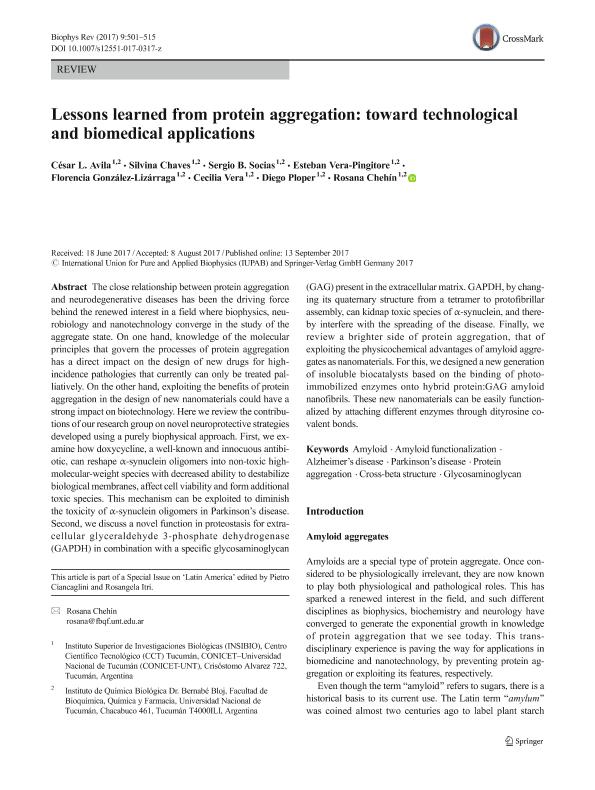Mostrar el registro sencillo del ítem
dc.contributor.author
Avila, Cesar Luis

dc.contributor.author
Chaves, Analia Silvina

dc.contributor.author
Socias, Sergio Benjamin

dc.contributor.author
Vera Pingitore, Esteban

dc.contributor.author
González Lizarraga, Maria Florencia

dc.contributor.author
Vera, Claudia Cecilia

dc.contributor.author
Ploper, Diego

dc.contributor.author
Chehin, Rosana Nieves

dc.date.available
2018-08-07T21:44:14Z
dc.date.issued
2017-10
dc.identifier.citation
Avila, Cesar Luis; Chaves, Analia Silvina; Socias, Sergio Benjamin; Vera Pingitore, Esteban; González Lizarraga, Maria Florencia; et al.; Lessons learned from protein aggregation: toward technological and biomedical applications; Springer Verlag Berlín; Biophysical Reviews; 9; 5; 10-2017; 501-515
dc.identifier.issn
1867-2450
dc.identifier.uri
http://hdl.handle.net/11336/54515
dc.description.abstract
The close relationship between protein aggregation and neurodegenerative diseases has been the driving force behind the renewed interest in a field where biophysics, neurobiology and nanotechnology converge in the study of the aggregate state. On one hand, knowledge of the molecular principles that govern the processes of protein aggregation has a direct impact on the design of new drugs for high-incidence pathologies that currently can only be treated palliatively. On the other hand, exploiting the benefits of protein aggregation in the design of new nanomaterials could have a strong impact on biotechnology. Here we review the contributions of our research group on novel neuroprotective strategies developed using a purely biophysical approach. First, we examine how doxycycline, a well-known and innocuous antibiotic, can reshape α-synuclein oligomers into non-toxic high-molecular-weight species with decreased ability to destabilize biological membranes, affect cell viability and form additional toxic species. This mechanism can be exploited to diminish the toxicity of α-synuclein oligomers in Parkinson’s disease. Second, we discuss a novel function in proteostasis for extracellular glyceraldehyde 3-phosphate dehydrogenase (GAPDH) in combination with a specific glycosaminoglycan (GAG) present in the extracellular matrix. GAPDH, by changing its quaternary structure from a tetramer to protofibrillar assembly, can kidnap toxic species of α-synuclein, and thereby interfere with the spreading of the disease. Finally, we review a brighter side of protein aggregation, that of exploiting the physicochemical advantages of amyloid aggregates as nanomaterials. For this, we designed a new generation of insoluble biocatalysts based on the binding of photo-immobilized enzymes onto hybrid protein:GAG amyloid nanofibrils. These new nanomaterials can be easily functionalized by attaching different enzymes through dityrosine covalent bonds.
dc.format
application/pdf
dc.language.iso
eng
dc.publisher
Springer Verlag Berlín

dc.rights
info:eu-repo/semantics/openAccess
dc.rights.uri
https://creativecommons.org/licenses/by-nc-sa/2.5/ar/
dc.subject
Alzheimer’S Disease
dc.subject
Amyloid
dc.subject
Amyloid Functionalization
dc.subject
Cross-Beta Structure
dc.subject
Glycosaminoglycan
dc.subject
Parkinson’S Disease
dc.subject
Protein Aggregation
dc.subject.classification
Otras Ciencias Biológicas

dc.subject.classification
Ciencias Biológicas

dc.subject.classification
CIENCIAS NATURALES Y EXACTAS

dc.title
Lessons learned from protein aggregation: toward technological and biomedical applications
dc.type
info:eu-repo/semantics/article
dc.type
info:ar-repo/semantics/artículo
dc.type
info:eu-repo/semantics/publishedVersion
dc.date.updated
2018-08-06T14:26:42Z
dc.identifier.eissn
1867-2469
dc.journal.volume
9
dc.journal.number
5
dc.journal.pagination
501-515
dc.journal.pais
Brasil

dc.description.fil
Fil: Avila, Cesar Luis. Consejo Nacional de Investigaciones Científicas y Técnicas. Centro Científico Tecnológico Conicet - Tucumán. Instituto Superior de Investigaciones Biológicas. Universidad Nacional de Tucumán. Instituto Superior de Investigaciones Biológicas; Argentina
dc.description.fil
Fil: Chaves, Analia Silvina. Consejo Nacional de Investigaciones Científicas y Técnicas. Centro Científico Tecnológico Conicet - Tucumán. Instituto Superior de Investigaciones Biológicas. Universidad Nacional de Tucumán. Instituto Superior de Investigaciones Biológicas; Argentina
dc.description.fil
Fil: Socias, Sergio Benjamin. Consejo Nacional de Investigaciones Científicas y Técnicas. Centro Científico Tecnológico Conicet - Tucumán. Instituto Superior de Investigaciones Biológicas. Universidad Nacional de Tucumán. Instituto Superior de Investigaciones Biológicas; Argentina
dc.description.fil
Fil: Vera Pingitore, Esteban. Consejo Nacional de Investigaciones Científicas y Técnicas. Centro Científico Tecnológico Conicet - Tucumán. Instituto Superior de Investigaciones Biológicas. Universidad Nacional de Tucumán. Instituto Superior de Investigaciones Biológicas; Argentina
dc.description.fil
Fil: González Lizarraga, Maria Florencia. Consejo Nacional de Investigaciones Científicas y Técnicas. Centro Científico Tecnológico Conicet - Tucumán. Instituto Superior de Investigaciones Biológicas. Universidad Nacional de Tucumán. Instituto Superior de Investigaciones Biológicas; Argentina
dc.description.fil
Fil: Vera, Claudia Cecilia. Consejo Nacional de Investigaciones Científicas y Técnicas. Centro Científico Tecnológico Conicet - Tucumán. Instituto Superior de Investigaciones Biológicas. Universidad Nacional de Tucumán. Instituto Superior de Investigaciones Biológicas; Argentina
dc.description.fil
Fil: Ploper, Diego. Consejo Nacional de Investigaciones Científicas y Técnicas. Centro Científico Tecnológico Conicet - Tucumán. Instituto Superior de Investigaciones Biológicas. Universidad Nacional de Tucumán. Instituto Superior de Investigaciones Biológicas; Argentina
dc.description.fil
Fil: Chehin, Rosana Nieves. Consejo Nacional de Investigaciones Científicas y Técnicas. Centro Científico Tecnológico Conicet - Tucumán. Instituto Superior de Investigaciones Biológicas. Universidad Nacional de Tucumán. Instituto Superior de Investigaciones Biológicas; Argentina
dc.journal.title
Biophysical Reviews
dc.relation.alternativeid
info:eu-repo/semantics/altIdentifier/doi/http://dx.doi.org/10.1007/s12551-017-0317-z
dc.relation.alternativeid
info:eu-repo/semantics/altIdentifier/url/https://link.springer.com/article/10.1007%2Fs12551-017-0317-z
Archivos asociados
